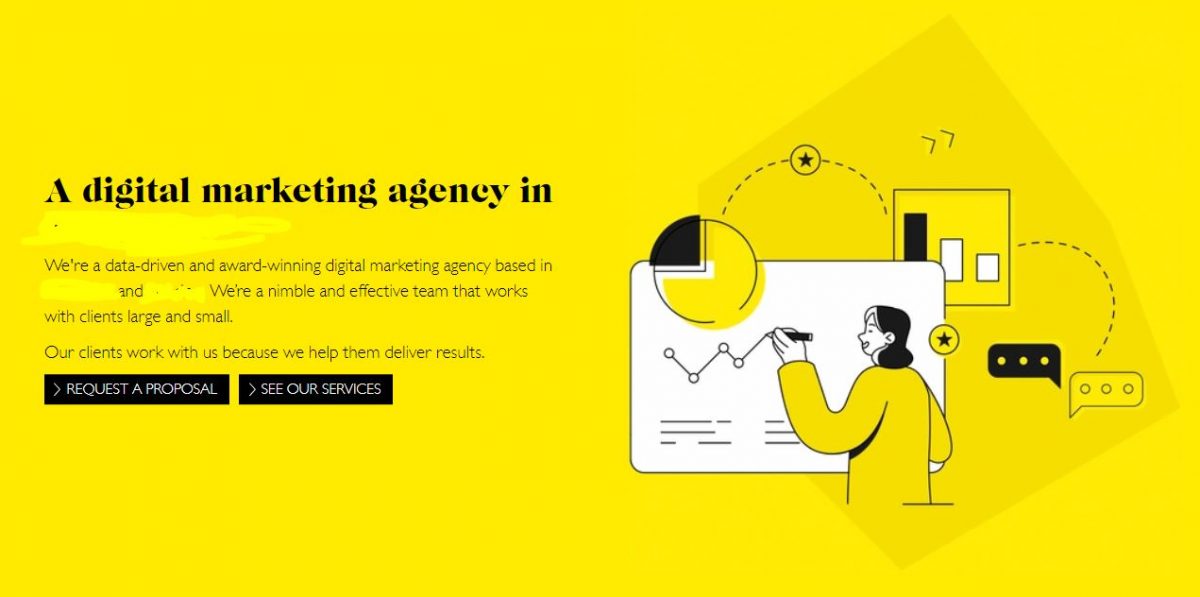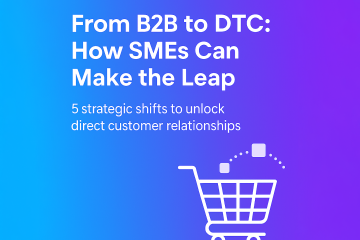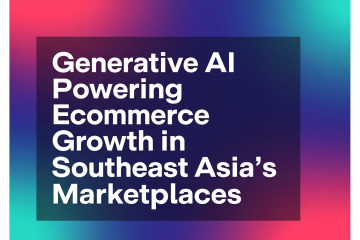We’ve reached the end of our 3-part, first-party data and lead generation series of articles. If you missed the first two, read them here and here. Now that you’ve identified your 1PD initiative and picked a tool to streamline the process, let’s cover the most common mistakes that EVERY SINGLE marketer has committed and how to avoid, and ideas on how to fix them.
This is a huge article, so grab some coffee and let’s dive right in.
A lot of these fall under basic marketing and copywriting, so there are tremendous ideas here for you to implement across your marketing endeavors. Let’s dive straight to the list:
- Not Knowing Ultimate Goal
- Audience Confusion
- Nothing Personal
- Ouch Points Ignored
- Narcissus In The House
- You Don’t Know Me, But Will You Marry Me?
- So Demanding
- It No Worky!
- Consistency
- Now What Am I Supposed to Do?
- Si(gh)lo Planning
- Oh So Vain (Metrics)
- Ignoring Microconversions
- We’re Done! Lack of Testing, Optimization, and Iteration
1. Not Knowing Ultimate Goal
With any new project, it’s very tempting to go straight to the “what” and “how” parts of the project and forget the basic “why are we doing this” discussion, especially once the tactics and tools are identified.
In your 1PD acquisition journey, the objective is not to get more data or acquire leads, those are just tactical in-betweens you have to do to meet your ultimate business goal.
Are you trying to drive a sales target? Get X number of attendees to make an event successful? Get Y number of existing customers to renew their contracts?
Know the ultimate goal before you even get started, just as we mentioned in this article.
Consider:
Sitting down with key stakeholders and the main sponsor of this project to identify the business objective using SMART goals before starting the project. Once a goal is determined, keep it on top of all your subsequent planning sessions to make sure you don’t deviate from this goal and that each stage leads you closer to achieving this goal.
2. Audience Confusion
Closely related to #1, if you don’t know your objective, odds are high that you have no clue who you’re going to talk to.
Imagine that you run a big box retail store and you want to capture leads to nurture them into learning the features and benefits of your new product that ultimately leads to a pre-order and you started your landing page with this headline:
“Acquire the whitepaper to our latest switch-mode enhanced portable voltage-controlled particulate removal filtration device!”

When all you really wanted to say was:
“Learn about our latest battery-powered vacuum cleaner!”
It really wouldn’t matter how much detail you put in your lead capture page, the headline is such a poor match to the intended audience’s expectations that you won’t even reach the 2nd sentence of your data capture form.
The example might be overkill, but think about how many communication pages you’ve seen in the market with really, really poor understanding of their target customers?
Consider:
Know your target audience in and out. The time you spend identifying basic marketing research such as customer personas, demographic and psychographic information, collating proven examples, and visualizing who you’re communicating with exactly will make your data acquisition a lot more precise.
3. Nothing Personal
All of these points are sequentially interconnected, without knowing your objective and audience, you’ll end up with lead capture pages that are bland and generic leading visitors that you spent money acquiring scratching their heads, wondering if what’s on the page matters to them or not.
Today’s technology allows a multitude of personalization options that allow dynamic and unique experiences to your target audience.
But even without tech, if you truly understand your audience, simply changing pronouns, word choices, and situational examples will do wonders.
Consider:
Explore starting your data capture with a basic survey or questionnaire form. Most CRM systems have built-in personalization tools and features or can integrate 3rd-party services to create personalized experiences. For example, simple pre-capture surveys asking demographic basics can automatically generate lead capture pages with appropriate pronouns or location words will dramatically increase relevancy to your audience.
4. Ouch Points Ignored
Most, if not all, products are created to solve a need or a pain point. A pain point doesn’t necessarily have to be a physical discomfort as mental needs such as obtaining better self-esteem still qualify as a pain point.
As a marketer, it’s your job to know exactly what your target audience’s pain points are and that you’re there to help address those pain points leading to their willingness to share personal data.
Most data capture lead pages focus on getting data without providing any value upfront. Remember that you’re asking them a favor, not the other way around.
It’s like going to the doctor with an itchy throat and they immediately told you to get lung surgery without even taking out their tongue depressor to look at you.

Consider:
Try using the classic “5 Whys” when you’re creating your data capture page. The 5-Whys exercise forces marketers to deep-dive into the core problems and desires of a customer.
In a nutshell, ask what pain point or problem your customer wants to solve, then follow up with a “why” is it important to solve that pain point. Repeat 3-4x towards the previous rationale to dig for the root cause. Here’s an example if you’re selling a budget tracking app:
Level 1 Pain Point: “I want to track my budget”
Why (is that important)?: “I need to know where my salary goes each month in spending”
Why (is that important)?: “Because I seem to be running out of cash 5 days before next payday”
Why (is that important)?: “I want to start saving some money every month”
Why (is that important?): “I want to build a 6-month emergency fund”
Why (is that important?): “I’m switching careers in a year and I want some peace of mind because it might take time before I can find a new job”
The relevancy of “why” will make your audience a lot more willing to share the data you need as they know you need it to help them solve their pain point.
5. Narcissus In The House
Here’s an easy one. Look at any page or collateral that your business has published and count how many times you mentioned your business, use the words “our”, “us”, and “we” (or “I”, if you’re a solopreneur”).
Shocking huh.

You’ve done all that hard work from #1-4 so far and as soon as your marketing team sits behind a keyboard, all that hard work goes out the window, and endless self-admiration kicks in.
It’s normal, it’s common – but it’s still wrong.
If you look at some of the world’s most successful brands that use data really well, the Apples, the Nikes, the Netflixes, they all have one thing in common. They put their customers in front as stars of the message.
They rarely mention their products, brands, and services explicitly, focusing only on knowing how you want to feel, what problem you want to solve, and so forth.
Bad marketing companies focus on themselves, and nobody cares.
Consider:
Go back to the pain points and craft your objectives on how you can solve the target audience’s problems and desires. Make sure that you’re there to move them closer to achieving those desires, but in order for you to help them, they’d need to share some relevant data with you.
6. You Don’t Know Me, But Will You Marry Me?
How we wish that we have the bravado and confidence of a marketer creating lead capture pages in real life.
You know, meeting someone for the first time, they say “hi”, you reply “I’m awesome, let’s get married!”
Sounds ridiculous? Unfortunately, that’s how most websites, lead generation forms, and marketing materials are crafted.
The page opens with why you’re so awesome, then go straight to asking the visitor to commit to making a time investment to:
- Fill up a form
- Type details on the project
- Look for your number and pick up the phone
- Download documents, whitepapers, and catalogs to see if your product fit their needs
- Look for pricing
- Figuring out features and options.
- etc.

What does the business have to do? NOTHING, just wait! What a life!
Consider:
If you’re objective is to capture relevant customer data, don’t forget to make sure it makes sense for THEM to do all the work. You do that by guiding the visitor through small commitments until they say yes.
Ask for the least amount of viable and usable data you can in your first interaction. Only the info you need to get more conversation going. Perhaps just a name and phone number or email rather than asking them to fill in their company name, address, phone number, position, annual budget, etc. It’s too early for that if you’re not giving something substantial upfront.
Remember, you’re the one in need of their business, they have options, put some effort and guide them along.
7. So Demanding
For example, if you’re at the beginning stages of looking for a car insurance quote, which would you prefer to fill up if you’re not ready to commit yet?

If you’re clueless about insurance, the form on the right asks for a lot of information that you either aren’t comfortable of giving, or you just don’t have the information to provide (for example, you haven’t bought the car yet).
Both are paid ad landing pages for car insurance and if your PRIMARY OBJECTIVE is to just know where your query is from and how to contact them the form on the left creates the zero-party data you need to make a more personalized experience for the user on the next screen.
The one on the right made a lot of assumptions about the visitor such as already knowing their car make and model, assuming they’ve already purchased the car (registered), and assuming the person previously owned a car or a policy (No claim discount).
That’s a lot to ask for your first interaction.
Consider:
As we covered in the previous article, collecting zero-party data is an excellent personalization opportunity, particularly for high-value conversion objectives like insurance where the lifetime value of a customer tends to be quite high.
From there, ask the minimal amount of data needed to move the needle to a more “hands-on” interaction with a customer or lead.
8. It No Worky!
From 404 pages to CTA buttons that don’t work. This irks the user in more ways than one. Even more so with data acquisition and lead capture pages.
Imagine convincing your audience well enough for them to finally fill up a form. You did so well with the points above that they’re actually willing to fill in a 20-question form only to click the Submit button that not only failed to collect the data, but cleared all the inputs they’ve entered as well.
I’ve filled in so many government survey forms or job application website forms that do this and it’s infuriating, I’m sure you have as well.
Even if it’s just a single question and a single button, you want to make sure everything works.
Consider:
Test your site before, during, and even after your data acquisition project. Test how it looks and works on mobile, desktop, and tablets. Test the readability, whether the buttons work, are there required fields that shouldn’t be. Check if the site crashes at load, etc.
9. Consistency
This one is quick and easy. Make sure you offer consistency in all your touchpoints! From color scheme to fonts to tone of voice. Don’t go from academic tone with black and white scheme to pastel candy theme full of memes all of a sudden.
Sounds funny, but serious brands trying to be funny are cringy as hell yet so common.
10. Now What Am I Supposed to Do?
“Too Many Cooks Spoil the Broth”
I can guarantee you’ll face this problem, it’s highly related to scope creep as well in project planning.
Your team has narrowed down your objectives, execution due diligence, and strategy. As the project moves along, one member from each group starts suggesting “it would be great if we add…” features to your lead generation project, the next thing you know, your lead capture page starts having a navigation bar, sidebar, a pop-up, multiple links inside the text, a form, social media buttons, and so forth.
Essentially, the single objective of capturing leads is derailed, and instead, you end up having a mini-website instead of a lead gen page, or a poster feature instead of a flyer.

Your audience sees the flyer but doesn’t know whether they should call or scan a QR code or visit a store. Since you’ve only set up your phone system to follow up on leads from these flyers, anyone who visited a store or scanned a QR code will not be associated with your project campaign.
The same goes with your new mini-website. Instead of asking visitors to fill up a form (the only objective you originally planned), 80% of your traffic ended up clicking on your blog links or connecting with you on social media and you end up not getting any data that the project is supposed to collect.
Consider:
Stick to ONE call to action. If the best way to collect data is through a form, turn off all other links, buttons, forms, or pop-ups that may distract your visitor.
If you’re using a less sophisticated data collection medium like print, make sure your options (phone, web, store) are all equipped to track conversions from the same flyer such as using a dedicated tracking code or a trunk line specific to lead capture, etc.
11. Si(gh)lo Planning
All of these are marketing activities, right? Wrong! Marketing in organizations tends to work in silos more than any other groups in projects, it seems. Particularly when digital technology is involved.

Imagine you crafted this great data capture initiative and everything looks pretty and on-point.
The day comes when all your leads start filling your form and relevant customer data starts piling in and the leads are excited to hear about your product.
Finally, the pre-order window opens and you’re getting hundreds of queries about how to order when the goods will be available, can you pay with credit cards, etc. Your customer service team was clueless about all the offers you’ve mentioned and everyone’s left hanging.
Your content mentioned that the goods will arrive in 30 days, but you weren’t aware that a gigantic cargo vessel was stuck in the Suez Canal for days causing at least a 15-day delay in transit.
You’re screwed.
Consider:
Just like any project, get all the stakeholders together and let each group know when their part goes on stage. If you’re pre-launching a physical product and running a lead collection campaign, coordinate with your supply chain to know when the goods will arrive.
Talk to the sales team on any possible discount tiers, vouchers, or giveaways to offer in the pre-during-post event after data capture.
Coordinate with your customer service team ahead of time to mitigate any pre-order concerns, queries, and returns.
Make sure your finance and IT teams know how the revenue will be captured in the system across email, SMS, chat, web, and other sales channel.
Get everyone involved early and constantly. It’s a team project, not marketing alone.
13. Oh So Vain (Metrics)
Vanity metrics make us feel good, the same way a shiny car or a new haircut do to our ego. It’s nice to look at, the layman will appreciate it quickly, and it looks nice on a presentation slide or report.
However, most of the time, these metrics fail to tell the team whether or not a goal was met. It only tells us whether or not a metric threshold has been met.
It’s like admiring how nice a Soprano singer pronounces a word and stops without wondering whether the song’s lyrics are moving, the score is enjoyable, or whether or not the singer can actually sing and sell tickets on stage.
Makes no sense, but marketers do this ALL THE TIME.
Don’t obsess over lowering your cost per click if the clicks don’t result in form completion.
Don’t obsess over improving how long a visitor stays on a page if the goal is to complete the form as quickly as possible. You can lengthen the time on the page by adding all sorts of useless content, but you’re not achieving anything.
And so forth.
Consider:
Don’t obsess over metrics. They’re means to your goal and they should be used in tandem with other metrics to form a KPI that matters.
Make sure the group of metrics you’ve chosen is interrelated that you can optimize individual parts to get better results in the end. The goal is not to improve metrics, it’s to improve efficiency and performance to achieve the goal.
14. Ignoring Microconversions
Say you’re about to leave for work. Do you magically reach your office desk the moment you step out of your house?
Of course not, unless Portal technology exists already.
You’d probably have to “succeed” in multiple small achievements to reach your destination starting with getting into your car, picking the right path, getting in your building, etc.
The same with your lead generation campaign. There are a lot of small wins you need to conquer before you hit your objectives, these are called microconversions.
Some examples of microconversions:
- Ad click to reach landing page
- User scrolling far enough to reach the value proposition and form
- Actually filling in the form
- Checking the opt-in privacy box
- Submitting the form
- Your sales team calling the lead in time
- etc.
In each of those stages, you need to come up with the right microconversion goal, KPIs, and metrics involved to track, test, and optimize.
Consider:
Think about every minute action your visitor has to take before they reach the end goal. No action is too trivial. From how their eyes go from left to right to the words you choose to how many scrolls and mouse clicks are required to fill in the form, figure out if there are any efficiency optimizations you can test and improve on.
You may be limited to the tech and measuring tools at your disposal, so start with the microconversions that you know affect outcomes the most such as copy, scroll, or form fields.
15. We’re Done! Lack of Testing, Optimization, and Iteration
Congratulations, you’ve found the magic formula that worked well for you! You’ve hit your data capture goals and met your business objective on budget and on time!
You’re done, right? If you need to do this again in 3 months, just repeat the whole thing.
The next quarter comes and your boss tells you that you need to run another lead capture project for a new product line, while the product is similar physically, this product is more high-end and targets an older audience.
You did exactly the same thing and you’re getting 1/4 the result of your previous campaign.
Perplexed, you did some research and realized that Facebook recently changed their ad targeting algorithm and there are new tools and requirements needed to replicate the previous results.
You’re now lost and probably have to do a lot of detective work to figure out what went wrong.
Consider:
Always stress-test what worked all throughout your project.
If you’ve found a winning form design, test it against another design. Perhaps add or remove one more field to change the lead qualification process. Perhaps change your ad targeting or budget, would it be more cost efficient to hit ad viewers 2x or 3x in form completion.
You’re not just collecting customer data, you always want to collect your own marketing experiment data as well.
If You Don’t Know, Now You Know
Heed the wise words of Biggie.
Take the list and run through each point with your overall team, particularly your marketing team. Don’t reach towards the end of your project and wonder what went wrong.

If you haven’t started your journey, that’s even better as you now have the guardrails to give your lead generation project a much higher chance of success, you can do it!




0 Comments